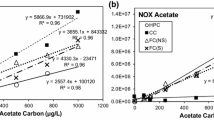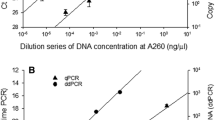Abstract
A technique was developed to evaluate alternative support systems to test tubes used in the standard most probable number technique, for simultaneous isolation and enumeration of cyanobacteria. Five different support systems were tested for their suitability in terms of accuracy, sensitivity, economics and ease of handling. PCR plates with 96 wells and carrying capacity of 300 µL per well were found to be most sensitive, besides being cost- and time-effective. This technique can also be useful for isolation of cyanobacteria, due to immobilization of colonies in the gel matrix and storage of samples at room temperature, without loss of viability for 5–6 weeks. This technique can help to process large sample size with ease — both for enumeration and isolation and can be extended for enumeration of other microorganisms from diverse sources.
Similar content being viewed by others
Abbreviations
- MPN:
-
most probable number
References
Johansen J.R.: Cryptogamic crusts of semiand and and lands of North America.J.Phycol. 29, 140–147 (1993).
Meynell G.C., Meynell E.W.:Theory and Practice in Experimental Bacteriology, 2nd ed. Cambridge University Press, London 1965.
Nayak S., Prasanna R., Pabby A., Dominic T.K., Singh P.K.: Effect of BGA —Azolla biofertilizers on nitrogen fixation and chlorophyll accumulation at different depths in soil cores.Biol.Fertil.Soils 40, 67–72 (2004).
Ruble P.A., Davis J.S.: Soil algae from fallow potato fields in south Florida (USA) marl.Nova Hedwigia 47, 403–414 (1988).
Shimmel S.M., Darley W.M.: Productivity and density of soil algae in an agricultural system.Ecology 66, 1439–1447 (1985).
Stanier R.Y., Kunisawa R., Mandel M., Cohen-Bazire G.: Purification and properties of unicellular blue-green algae (orderChroococcales).Bacteriol.Rev. 35, 171–205 (1971).
Starks T.L., Shubert L.E.: Colonization and succession of algae and soil-algal interactions associated with disturbed areas.J.Phycol. 18, 99–107 (1982).
Tchan Y.T.: Study of soil algae. III. Bioassay of soil fertility by algae.Plant & Soil 10, 220–232 (1959).
Tsujimura S., Nakahara H., Kosaki T., Ishida N., Iskakov A.R.: Distribution of soil algae in salinized irrigation land in the arid region of Central Asia. II. A case study of 25-year-old Bakbakty farm in the flood plain of the River Ili, Kazakstan.Soil Sci. Plant Nutr. 44, 67–76 (1998a).
Tsujimura S., Nakahara H., Kosaki T., Ishida N., Karbozova E.: Distribution of soil algae in salinized irrigation land in the arid region of Central Asia. I. A case study of 14-year-old Bereke farm in the flood plain of the River Ili, Kazakstan.Soil Sci.Plant Nutr. 44, 53–65 (1998b).
Tsujimura S., Nakahara H., Ishida N.: Estimation of soil algal biomass in salinized irrigation land: a comparison of culture dilution and chlorophylla extraction methods.J.Appl.Phycol. 12, 1–8 (2000).
Vaara T., Vaara M., Niemela S.: Two improved methods for obtaining axenic cultures of cyanobacteria.Appl.Environ.Microbiol. 38, 1011–1014 (1979).
Vítová M., Hendrychová J., Cepák V., Zachleder V.: Visualization of DNA-containing structures in various species ofChlorophyta, Rhodophyta andCyanophyta using SYBR Green I dye.Folia Microbiol. 50, 333–340 (2005).
Whitton B.A.: Soils and rice fields, pp. 235–255 in B.A. Whitton, M. Potts (Eds):Ecology of Cyanobacteria: Their Diversity in Time and Space. Kluwer Academic Publishers, The Netherlands 2000.
Zimmerman W., Metting B., Rayburn W.: The occurrence of blue-green algae in silt loams of Whitman County, Washington.Soil Sci. 130, 11–18 (1980).
Author information
Authors and Affiliations
Corresponding author
Rights and permissions
About this article
Cite this article
Prasanna, R., Saxena, A.K., Jaiswal, P. et al. Development of alternative support system for viable count of cyanobacteria by most probable number method. Folia Microbiol 51, 455–458 (2006). https://doi.org/10.1007/BF02931590
Received:
Revised:
Issue Date:
DOI: https://doi.org/10.1007/BF02931590




